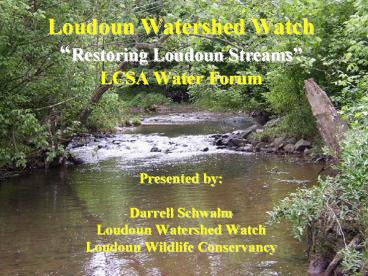Loudoun Watershed Watch - PowerPoint PPT Presentation
Title:
Loudoun Watershed Watch
Description:
Loudoun Watershed Watch Restoring Loudoun Streams LCSA Water Forum Presented by: Darrell Schwalm Loudoun Watershed Watch Loudoun Wildlife Conservancy – PowerPoint PPT presentation
Number of Views:145
Avg rating:3.0/5.0
Title: Loudoun Watershed Watch
1
Loudoun Watershed WatchRestoring Loudoun
StreamsLCSA Water ForumPresented
byDarrell SchwalmLoudoun Watershed
WatchLoudoun Wildlife Conservancy
2
Loudoun Watershed Watch
- Loudoun Watershed Watchformed in 2001 alliance
of county stream stewardship groups - Compiled countywide stream monitoring data and
published, State of Loudoun Streams 2002 Report. - Complied updated, State of Loudoun Streams 2005
Report.
3
LWWs Vision
LWW shares a common vision with citizens across
the nation clean and safe water, and healthy
aquatic ecosystems. For citizens in Loudoun,
this means a county distinguished for its cool
meandering streams with wide, forested riparian
buffers flowing through woodlots, farms,
residential communities, and parks with
streamside trails.
4
LWW Educational Initiatives
- LWW distributed the first Loudoun watershed map
and activity guide for Loudoun's 37,000 public
school students. - LWW distributed a summary report on stream health
in Loudoun County - LWW organized the Catoctin Watershed Project to
support TMDL implementation
5
LWW Community Stewardship Events
Catoctin Riparian Buffer Restoration Waterford
Area -- 2005
6
Catoctin Creek Clean-up Stewardship Event
Taylorstown -- 2005
7
Loudoun Family Stream Day
Watershed Model at Broadlands Community Center -
2005
8
Task 1 -- Where Do We Start Looking for Problems?
9
What Do VA DEQ Reports Tell Us?
- Impaired Waters Loudoun streams are impaired
they dont meet state water quality standards and
they are often not safe for recreational use - Sugarland Run Broad Run
- Goose Creek Sycolin Creek
- Tuscarora Creek Little River
- NF Goose Creek Beaverdam Creek
- Catoctin Creek NF Catoctin Creek
- SF Catoctin Creek Piney Run
- Limestone Branch
10
Fecal pollution from livestock with access to
streams is the 1 cause of impairments
11
Erosion caused by livestock fill our streams with
sediments that destroy habitat for aquatic life
and pollute the Chesapeake Bay
12
What Does a Tour of Loudoun Streams Tell Us?
Developments are destroying riparian buffers,
increasing stream flows, and eroding stream banks
13
High volume stormwater flows in urban areas are
polluting our streams and erode stream banks
14
Homeowners and HOAs provide poor maintenance of
stormwater drainages from impervious surfaces
15
Flooding, erosion and sediments are creating poor
habitats for aquatic life in many streams
16
Why can we find so many problems everywhere we
look? Arent BMPs suppose to be protecting
Loudoun streams? Sadly, the answer is no . . .
17
BMPs Are Not Protecting Against Downstream
Property Damage
BMP protection against erosion from a three-year
rain is not enough.
18
BMPs Are Not Preserving Natural Capacity to
Filter and Purify
Clearing forested buffers and grading floodplains
remove capacity to filter and purify.
19
BMPs Are Not Supporting Healthy Streams and
Aquatic Life
Algae growth in stream from sediments and
nutrients in runoff from development
20
Property Owners Complaints About One Upstream
Development
Type of Complaint (Submitted to Building and Development) Number of Complaints
Heavy sediments in stream 9
Inadequate BMP controls along stream 5
Added drainage requires new culvert or control 4
Stream water has a green coloration 1
21
Some Reasons Why BMPs Arent Working
- County does not have performance standards to
insure that water quality standards are met by
developer. - Property owners have no rights if BMPs installed
by developers do not protect against downstream
damage.
22
Standards are Designed to Allow Erosion and
Flooding
- Stormwater controls are designed to prevent
erosion only from 3-year rainfalls - Stormwater controls are designed to prevent
floods only from 10-year rainfalls - With greater rains -- there will be erosion and
flooding caused by developments by design.
23
County Ordinance do not Require Environmental
Studies
- Environmental studies are needed to establish
baseline water quality and habitat conditions at
planned development sites. - Such studies for future developments in
floodplains are not required only voluntary
24
Task 2 Where Do We Look for Solutions?
25
Look in Your In Basket!
26
Upgrade Our BMPs!
We dont want this to happen again
27
BMPs What the Experts Tell Us is Needed
- Appropriate precipitation analysis will result
in correct sizing of BMPs and protection of
streams.
- Alternative BMPs are needed to complement
watershed-level BMPs
?Structural BMPs
?Vegetative BMPs
?Construction BMPs
?BMP Retrofitting
?LID and Pollution Prevention Activities
28
Watershed Management Planning!
- Loudoun County needs to develop plans to
implement the Federal Clean Water Act, the
Chesapeake Bay Act, and Virginia Water Quality
Standards
29
Loudoun Water Management Authority!
Loudoun County should create a water management
authority to develop watershed management plans
for each watershed, and oversee initiatives to
restore the quality of Loudoun streams
30
Countywide Stream Monitoring Program!
Loudoun County needs a countywide stream
monitoring program to provide data to develop
watershed plans, and to assess impacts of new
BMPs on water quality and stream health.
31
Collaboration between State, County, and Citizens!
We need to combine resources to tackle water
pollution
- DEQ
- DCR
- Loudoun Soil and Water Conservation District
- Loudoun County Health Department
- Loudoun County Building and Development
- Loudoun County General Services, Public Works
- Loudoun County Planning
- Loudoun County Sanitation Authority
- Citizen Groups
32
County--Citizen partnership is the best way to
solve problems like these . . .
33
. . . and to help educate riparian property
owners.
34
Where to Find Information About Citizen Activities
- Websites
- www.LoudounWatershedWatch.org
- www.Loudounwildlife.org
- www.Audubonnaturalist.org
- Sites Include
- Educational Materials
- Water Quality Data
- LWW State of Loudoun Streams Reports
- Catoctin Watershed Project Accomplishments
35
Why Do Citizens Monitor?
"We monitor because we care we care
because we are informed we are informed
because we monitor. Cassie Champion, of the
Minnesota Metropolitan Council,
http//www.riversmn.org/resources_monarticles.htm
lMonitoring20Bacteria































